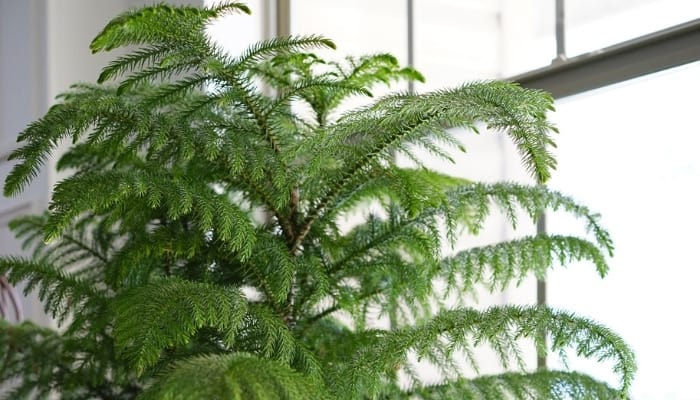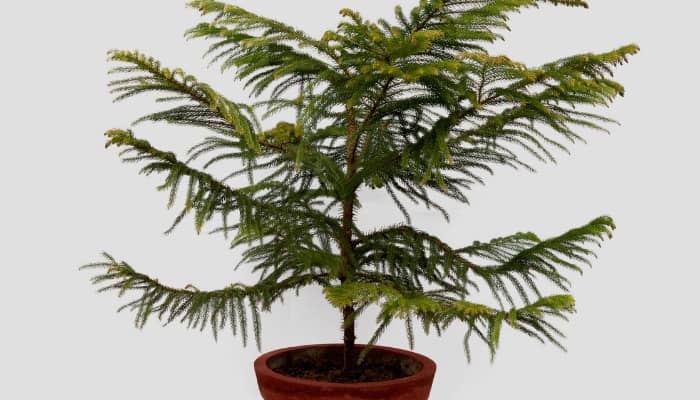If you have made the decision to have a potted evergreen tree indoors, but are unsure of which type to choose, you may encounter some difficulties.
Pine, of course, is a natural choice as it is one of the most popular and well-known of all evergreen trees.
Can you grow a pine tree indoors? Pine trees, like most evergreens, can be grown indoors, but they do require some time outdoors throughout the year, unlike many other potted trees and houseplants. Otherwise, pine is relatively low maintenance for an indoor tree.
Read on below and learn everything you need to know about how to grow and care for a pine tree indoors!
How To Grow a Pine Tree Indoors
Growing a pine tree indoors is much easier than you may have been led to believe it was!
That said, there are several basics about growing pine trees that you need to understand in order to maintain a thriving indoor tree.
Pine trees are not like African violets or orchids, as they require very little maintenance beyond basic care.
In the following sections, we break down how to select, pot, water, fertilize, and generally grow/care for an indoor pine tree.
Step 1. Selecting Your Pine Tree
The very first step to growing a pine tree indoors is, of course, selecting your pine tree. The biggest factor to take into consideration is the health of the tree.
Look for trees with lots of green and little to no brown tips (though some golden tips are just fine).
Try to find a tree that fits in the spot you have picked out for it in your home. Also, keep in mind that the larger the tree, the more work it takes to maintain.
Pine trees are pretty basic, but they will require a bit of pruning each year. Smaller trees are also easier to move in and out of the house (or even just move around from place to place inside).
Types of Indoor Pine Trees
Pine trees belong to a family of plants/trees that are known as conifers. There are over 120 species within the group.
Nearly any type of pine can be grown indoors, though some species are more popular than others. A few of the most common types of indoor pine trees include:
- Virginia pine
- Shortleaf pine
- Sugar pine
- Longleaf pine
- Ponderosa pine
- Mountain pine
- Norfolk Island pine
- Jack pine
- Stone pine
- White pine (Eastern and Western)
- Red pine
- Pitch pine
Again, there are over 120 species of pine to choose from, just about all of which work as indoor trees.
Step 2. Potting Your Pine Tree
The first thing to understand about potting your pine tree is that it doesn’t want the same fluffy soil as your flowers or even the rich compost that goes into your garden’s raised beds.
Pine trees prefer sandy quick-draining soil that is constantly moist. Bonsai soil mixes (find them here) also work well for pine trees (if you want to purchase a pre-mixed soil for your tree).
Start the potting process by placing 2 to 4 inches of gravel or stones in the bottom of your tree’s pot. Continue by tossing in enough of the soil mix to cover the tops of the rocks.
Next, place the tree’s root ball directly into the center of the bottom of the pot. Spread the roots out in all directions as much as possible (without forcing any), and cover them with soil.
Gently but firmly press the soil down over the roots, and continue adding new layers until they are covered by several inches.
Fill the container the rest of the way up with soil mix, just leaving the top 4 or 5 inches empty.
If you have mulch or woodchips, add 2 to 3 inches to the very top of the pot, and you are ready to move on to the next step.
Step 3. Watering and Fertilizing an Indoor Pine Tree
Pine trees are a lot like indoor spruce, cedar, and bonsai trees; they enjoy a little sip of water every day but just enough to keep them moist.
Technically speaking, indoor pine trees can go as much as 1 to 2 weeks without watering. That said, it isn’t recommended to let the soil dry out between watering.
As far as fertilization goes, pines really don’t need much. You simply can fertilize them each year when you repot them, or you can give them liquid fertilizer (this one is very good) every few months.
Step 4. Replicating Natural Conditions
Pine trees in nature thrive where there is plenty of sunlight all day long and moist but well-draining soil. That’s why you see so many of them along rivers and lake banks.
Indoors, make sure your pine tree gets at least 8 to 10 hours of indirect sunlight from windows and lights.
Also, take care that its soil doesn’t ever dry out fully. Giving it a little drink of water each day recreates what it would experience with morning dew.
Step 5. Repotting an Indoor Pine Tree
Repotting indoor pine trees is best done in the spring when the buds aren’t growing yet. However, repotting them a few months later during late summer or early autumn is another popular option.
Whether it’s to change the aesthetics with a new container or to refresh the soil and fertilize the tree, your indoor pine benefits from being repotted every 12 to 18 months.
To repot your pine, simply follow the same process outline in Step 2 of this how-to guide.
One additional step is soaking the tree’s root ball in room temperature water for 15 to 30 minutes in between unpotting and repotting.
Do Pine Trees Need To Be Trimmed?
Pine trees are one of the few species that don’t necessarily need to be trimmed often, if ever. Typically, damaged or dying areas of pine trees are the only parts that need trimming.
However, trimming also encourages thicker regrowth, so it can be beneficial if creating a bushy little tree is your goal. At any rate, early spring and autumn are the best times to do so.
How To Trim a Pine Tree That’s Too Tall

The best way to trim an indoor pine tree that’s too tall is to start with the central branch. Hold the tip of it, and snip it to the preferred height.
Next, move on down the tree, snipping the tips of the branches you think need to be shorter in order to give it the shape you desire.
Can a Potted Pine Tree Remain Indoors Indefinitely?
Potted pine trees benefit greatly from being transported outdoors, at least from time to time. They can survive in the house, practically forever, but the fresh air and full sunlight do them a world of good.
The longer a pine tree stays inside though, the more it adapts to its environment.
As long as you keep it well fed, ensure it receives adequate light, and maintain a manageable size, it should be able to remain there for the remainder of its lifespan.
When To Transplant Your Indoor Pine Tree Outside
Whether it’s getting too big for the indoors or you’ve outgrown it, you can always choose to transplant your indoor pine back into the great outdoors at some point in time.
The best time to transplant pine trees outside is when the temperature isn’t likely to jump too high or plunge too low.
Late August, September, and on into October are the most recommended times of the year to get this task completed.
Related Questions:
How Much Water Does a Pine Tree Need?
Technically speaking, pine trees need around 1 inch of water each week. Indoors, that equates to one thorough soaking every 5 to 10 days or a “drink” of water each day.
How Tall Do Pine Trees Get?
Indoors, pine trees rarely grow taller than 6 feet, though most of the time are much smaller. In nature, pine trees can grow to heights towering well over 100 feet.
The world’s tallest pine tree, named “Phalanx,” is nearly 269 feet tall.
Conclusion
Granted, growing and caring for indoor pine trees isn’t as hard as learning how to grow and care for some house plants, but they still do require a site of attention.
Like bonsai trees, indoor pines enjoy quick-draining soil that gets watered daily, lots of constant but indirect sunlight, light fertilization, and generally being fawned over by people!

